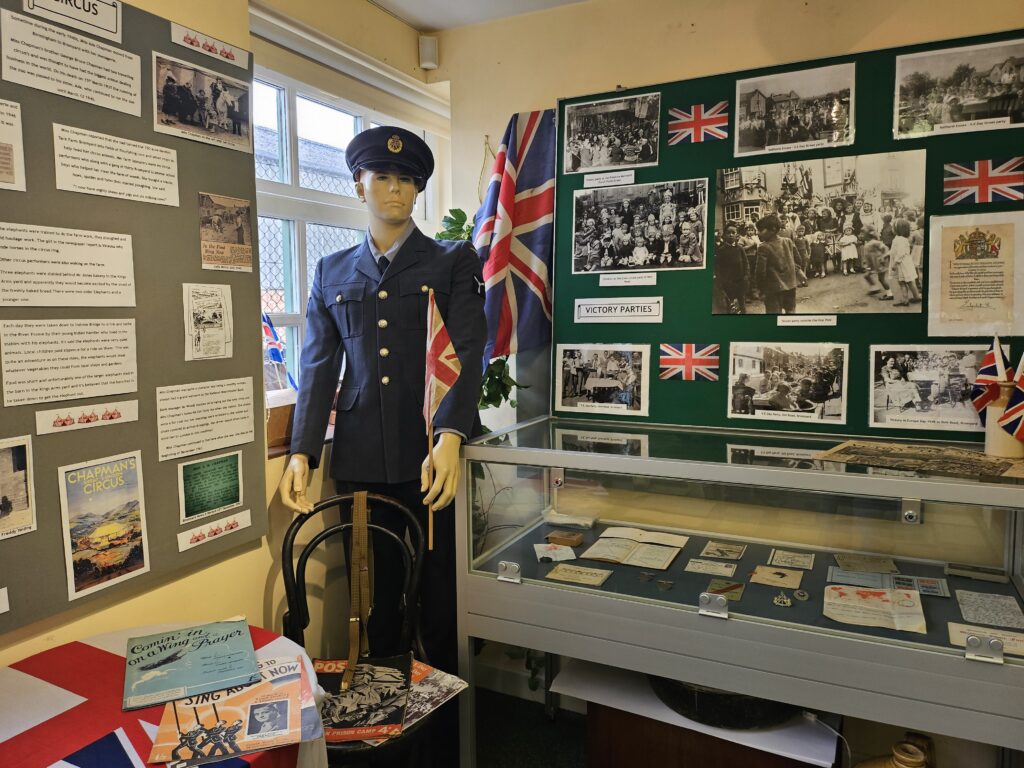On May 8th, 1945, WWII in Europe came to an end. As the news of Germany’s surrender reached the rest of the world, joyous crowds gathered to celebrate in the streets of Bromyard, clutching newspapers that declared “Victory in Europe”, V-E Day.

When victory eventually came a weary nation were understandably keen to celebrate; street parties and parades were held, bonfires lit and church bells were rung.
But it was a day of mixed emotions; many people felt unable to celebrate as they mourned the death of a loved one, or worried about those who were still overseas.
For people in Bromyard and the rest of the country, the end of the fighting didn’t mean an end to the impact of the war on their lives. Although many things slowly began to return to normal, it took time to rebuild the country, rationing remaining for several years.

The exhibition is accomanied by a book, exploring Bromyard during the Second World War, bringing all the well-known national characteristics of the war into sharp focus, using the memories of local people to bring rationing, the Home Guard, the Land Army, evacuees and Prisoners-of-War, to name but a few, clearly to life in their local context.
The Land Army
Away from the well-documented horror of the battlefields, World War Two was a time of immense social change. The Women’s Land Army, affectionately known as ‘Land Girls’ were a big part of that, as labour shortages meant women took on the roles traditionally held by men.
By 1934 there were more than 80,000 Land Girls. Women like Joan Watkins, Peggy Calder, Gladys Hoskins and Joy Atkins. Come and learn more about their fascinating stories and the important contribution the women working in Bromyard made to the war effort.
Evacuees
The evacuees had to adapt quickly to country life coming from London and Birmingham for some, it was the first time the bus services were frequent, if you lived outside of Bromyard or in a small hamlet you might have to walk two to three miles to school. they had seen cows, sheep, chickens and pigs. It was strange going into homes not knowing the families they were placed with, leaving their mothers and sometimes being separated from their brothers and sisters as some households could only take one child. Transport was another problem as in London and other cities
Rationing
When World War II began in September 1939, petrol was the first commodity to be controlled. On 8 January 1940, bacon, butter, and sugar were rationed. Meat, tea, jam, biscuits, breakfast cereals, cheese, eggs, lard, milk, canned and dried fruit were rationed subsequently, though not all at once. In June 1942, the Combined Food Board was set up by the United Kingdom and the United States to coordinate the world supply of food to the Allies, with special attention to flows from the U.S. and Canada to Britain. Almost all foods apart from vegetables and bread were rationed by August 1942. Strict rationing created a black market. Almost all controlled items were rationed by weight; but meat was rationed by price.
The Home Guard
Men who were eager to ‘do their bit’ but were unable to enlist for the regular forces due to age or being in a reserved occupation joined the Home Guard. Despite being seemingly far from the action Herefordshire’s Home Guard platoons still had important work to do; they were tasked with monitoring the skies for German bombers and trained in street fighting in preparation for any invasion. Alongside them existed a ‘secret army’ – the Auxiliary Units – who in the event of an invasion were expected to go to ground in their base, living underground for up to two weeks before emerging to carry out acts of sabotage and provide useful intelligence.








